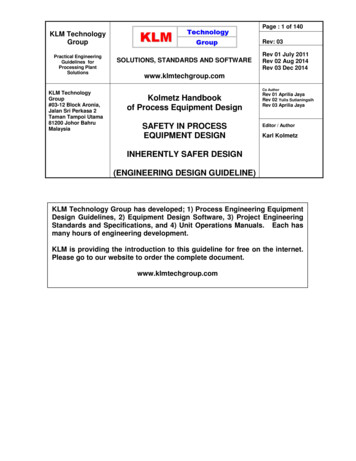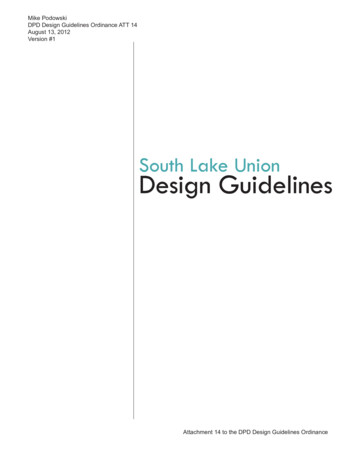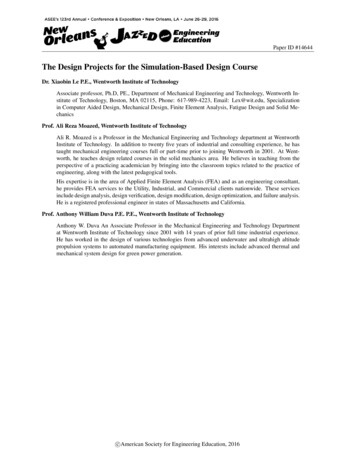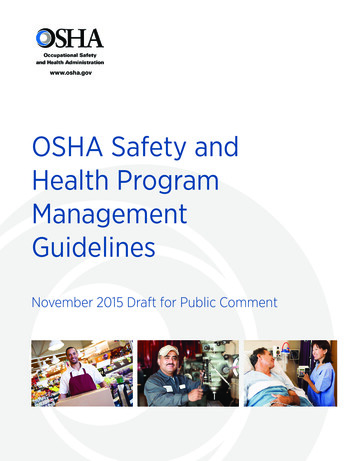
Transcription
Page : 1 of 140KLM TechnologyGroupPractical EngineeringGuidelines forProcessing PlantSolutionsKLM TechnologyGroup#03-12 Block Aronia,Jalan Sri Perkasa 2Taman Tampoi Utama81200 Johor BahruMalaysiaRev: 03SOLUTIONS, STANDARDS AND SOFTWARERev 01 July 2011Rev 02 Aug 2014Rev 03 Dec 2014www.klmtechgroup.comCo AuthorKolmetz Handbookof Process Equipment DesignSAFETY IN PROCESSEQUIPMENT DESIGNRev 01 Aprilia JayaRev 02 Yulis SutianingsihRev 03 Aprilia JayaEditor / AuthorKarl KolmetzINHERENTLY SAFER DESIGN(ENGINEERING DESIGN GUIDELINE)KLM Technology Group has developed; 1) Process Engineering EquipmentDesign Guidelines, 2) Equipment Design Software, 3) Project EngineeringStandards and Specifications, and 4) Unit Operations Manuals. Each hasmany hours of engineering development.KLM is providing the introduction to this guideline for free on the internet.Please go to our website to order the complete document.www.klmtechgroup.com
Kolmetz Handbookof Process Equipment DesignKLM TechnologyGroupSafety in ProcessEquipment DesignPractical EngineeringGuidelines for Processing PlantSolutions(ENGINEERING DESIGN GUIDELINES)Page 2 of 140Rev: 03December 2014TABLE OF CONTENTINTRODUCTION5Scope5General Design Considerations6A. Safety Requirements11B. Safety Program10C. Engineering Ethics13D. Statistics14E. Acceptable Risk & Public Perceptions18F. Hazard and Operability Analysis (HAZOP)18G. Material Hazard22H. Fire and Gas Protection26I. Inherent Safety32DEFINITIONS35THEORY38Safety Studies39The Design Process41Site Selection46Plant and Unit Layout49
Kolmetz Handbookof Process Equipment DesignKLM TechnologyGroupSafety in ProcessEquipment DesignPractical EngineeringGuidelines for Processing PlantSolutions(ENGINEERING DESIGN GUIDELINES)Page 3 of 140Rev: 03December 2014Storage Tank63Distillation67Reactors71Heat Transfer System74Piping System77Flare83Pressure Relief Systems and Specifying Valves to Increase Safety89An Electrical Area Classification93Inherently Safer Design94A. Key Elements94B. History94C. Basic Concept97D. Chemical Process Safety Strategies98E. Inherently Safer Design Processes100F. ISD in the Process Design Life Cycle104G. Transportation107H. Human Factors108I. Concerns112J. ISD Implementation113K. The Myths114L. Conceptual ISD in Plant115
Kolmetz Handbookof Process Equipment DesignKLM TechnologyGroupSafety in ProcessEquipment DesignPractical EngineeringGuidelines for Processing PlantSolutions(ENGINEERING DESIGN GUIDELINES)Page 4 of 140Rev: 03December 2014Emergency Shut Down (ESD)119Hazard Identification Methods Summary124APPLICATION126REFERENCES134LIST OF TABLETable 2 : Accident Statistics16Table 3 : FAR Statistics17Table 4 : Guide Words for HAZOPS Studies19Table 5 : Typical material characteristic24Table 6 : Recommended velocities for commonly service82Table 7 : Zone Classification93Table 8 : Inherently Safety Techniques101Table 9 : The conceptual design phase opportunities115Table 10: Efforts aimed at creating less hazardous conditions may be effective.116Table 11: look for ays to simplify complex designs during the detailed design phase117Table 12 : human factors should be re-examined during the procurement / constructionphase118
Kolmetz Handbookof Process Equipment DesignKLM TechnologyGroupSafety in ProcessEquipment DesignPractical EngineeringGuidelines for Processing PlantSolutions(ENGINEERING DESIGN GUIDELINES)Page 5 of 140Rev: 03December 2014LIST OF FIGUREFigure 1 : Causes of losses in the largest hydrocarbon-chemical plant accidents9Figure 2 : Hardware associated with largest losses9Figure 3 : Ingredients for successful safety prgoram12Figure 4 : HAZOP Proceudre Illustration21Figure 5 : Failure in Safety Management32Figure 6 : Causes of Control System Incidents43Figure 7 : Inherent safety review preparation45Figure 8 : Inherent safety review46Figure 9 : Typical plant Layout60Figure 10 : Type of storage tank : (a) Sphere, (b) Cylinder67Figure 11 : Layout of Distillation70Figure 12 : Simplicity chemical reactor73Figure 13 : Heat transfer system in heat exchanger77Figure 14 : Layout of piping system83Figure 15 : Steam Assisted Elevated Flared System88Figure 16 : Pressure Relief Valve91Figure 17 : Traditional Risk Management96Figure 18 : Chemical Process Safety Strategies99Figure 19 : Inherently Safer Design in the Process Design Life Cycle106Figure 20 : Illustration of Never Exceed Limits111Figure 21 : ISD Implementation113Figure 22 : Emergency shut down (ESD) principle hierarchy123Figure 23 : Seveso Reactor105
KLM TechnologyGroupPractical EngineeringGuidelines for Processing PlantSolutionsKolmetz Handbookof Process Equipment DesignSafety in ProcessEquipment Design(ENGINEERING DESIGN GUIDELINES)Page 6 of 140Rev: 03December 2014INTRODUCTIONScopeThis design guideline covers safety issues in process equipment design including chemical,petrochemical, and hydrocarbon processing facilities. It assist personnel to understand thebasic concepts of process safety and increase the knowledge of prevention and reduce theincidents that might happen.The design consideration discussed is methods of safety; 1. Inherently safer design, 2.Hazard and Operability Analysis (HAZOP) 3. material hazards and 4. fire protection.Reviewed are plant and unit layout, equipment spacing and some equipment which in whichincidents might happen such as storage tank, distillation, reactors, piping system, flare andpiping system.It is clear that choices made early in design can reduce the possibility for large releases andmay reduce the effects of releases. One should consider the variety of mitigation measuresto reduce the severity of the effects of a release,
KLM TechnologyGroupKolmetz Handbookof Process Equipment DesignSafety in ProcessEquipment DesignPractical EngineeringGuidelines for Processing PlantSolutions(ENGINEERING DESIGN GUIDELINES)Page 7 of 140Rev: 03December 2014General Design ConsiderationsThe comparison of the safety of equipment is not straightforward. It depends on severalfeatures of both process and equipment themselves. It can be evaluated from quantitativeaccident and failure data and from engineering practice and recommendations.Unit operations may include physical operations and further processing or preparation forfurther reactions or for shipment. These operations include mixing or separating, sizereduction or enlargement, and heat transfer. General hazards in physical operations are:1. Vaporization and diffusion of flammable liquids and gases2. Spraying or misting of flammable liquids3. Dispersion of combustible dusts4. Mixing highly reactive chemicals5. Increase in the temperature of unstable chemicals6. Friction or shock of unstable chemicals7. Pressure increase in vessels8. Loss of inertants or diluentsSome of the safety elements that can be included on the flow sheets are:1. Process materials properties2. Process conditions (pressure, temperature, composition)3. Inventory4. Emergency and waste releases5. Process control philosophy
KLM TechnologyGroupPractical EngineeringGuidelines for Processing PlantSolutionsKolmetz Handbookof Process Equipment DesignSafety in ProcessEquipment Design(ENGINEERING DESIGN GUIDELINES)Page 8 of 140Rev: 03December 2014When considering the design aspects of a project, it can be identified three approaches tofault management that are of particular importance:1. System Architecture The system architecture has an enormous effect on the ability ofa system to tolerate faults within it. It can provide some protection against randomcomponent failure and some forms of systematic fault. It does not usually tackle theproblems associated with specification faults.2. Reliability Engineering. This is primarily concerned with the susceptibility of a systemto random hardware component failures. However, some engineers believe that thesetechniques may also be applied to some systematic faults.3. Quality Management Considerations of quality cover all aspects of a system’s life andare therefore of great importance to fault management.In addition, good plant operating practice would include1. Written instruction in the use of the hazardous substances and the risks involved.2. Adequate training of personnel.3. Provision of protective clothing and equipment.4. Good housekeeping and personal hygiene.5. Monitoring of the environment to check exposure levels. Consider the installation ofpermanent instruments fitted with alarms.6. Regular medical checkups on employees, to check for the chronic effects of toxicmaterials.7. Training of local emergency response personnel.
KLM TechnologyGroupPractical EngineeringGuidelines for Processing PlantSolutionsKolmetz Handbookof Process Equipment DesignSafety in ProcessEquipment Design(ENGINEERING DESIGN GUIDELINES)Page 9 of 140Rev: 03December 2014Certain types of processes, process conditions, or fluids handled introduce factors whichaffect the safety of the plant. These factors must be taken into consideration in the design.They include:1. High-severity operating conditions, e.g., extremes of temperature or pressure.2. Batch or cyclic processes or processes undergoing frequent startup and shutdown,where the opportunities for operating error are greater than normal.3. Processes subject to frequent upsets by integration with other plants or wheredangerous conditions may arise from utility failures.4. Unstable processes, in which decompositions, temperature runaways, or otherunstable reactions are possible5. Fluid solids processes, in which stable and safe operations depend on theeffectiveness of fluidization of solids to prevent reverse flow, e.g., catalytic cracking.6. Fluid properties and characteristics such as flammability, vapor pressure, autorefrigeration, corrosion, erosion, toxicity, and chemical reactivity, including thevariations in these properties which may occur at abnormal operating conditions.7. Start up or shut down is an infrequent activity.Therefore, startup andemergency/normal shutdown procedures must be as simple and logical as possible.This must be incorporated into design considerations.8. High noise evolution may pose communications problems and impair operatorperformance by creating additional stress.Figure 1 presents the causes of losses for the largest chemical accidents. By far the largestcause of loss in a chemical plant is due to mechanical failure. Failures of this type are usuallydue to a problem with maintenance. Pumps, valves, and control equipment will fail if notproperly maintained.The second largest cause is operator error. For example, valves are not opened or closed inthe proper sequence or reactants are not charged to a reactor in the correct order. Processupsets caused by, for example, power or cooling water failures account for 11% of the losses.While figure 1 presents a survey of the type of hardware associated with large accidents.
KLM TechnologyGroupPractical EngineeringGuidelines for Processing PlantSolutionsKolmetz Handbookof Process Equipment DesignSafety in ProcessEquipment Design(ENGINEERING DESIGN GUIDELINES)Page 10 of 140Rev: 03December 2014Figure 1: Causes of losses in the largest hydrocarbon-chemical plant accidents (13)Figure 2 : Hardware associated with largest losses (13)
KLM TechnologyGroupPractical EngineeringGuidelines for Processing PlantSolutionsKolmetz Handbookof Process Equipment DesignSafety in ProcessEquipment Design(ENGINEERING DESIGN GUIDELINES)Page 11 of 140Rev: 03December 2014A. Safety RequirementsSafety Requirements Specification is a specification that contains all the requirements of thesafety instrumented functions that have to be performed by the safety instrumented systems.The safety requirements should have a safe state whereas described as a state of theprocess when safety is achieved. In some cases the process may have to go through anumber of states before the process enters the final safe state. Actions necessary to keep asafe state in the event of detected fault(s) should be described. The description must addresssafe state details regarding process actions needed, in example : Sequential shutdown.Which process valve(s) is needed to perform a specific action during the safe state.Fluid flow choices that need to be started or stopped.Stop, start or continue operation of rotating elements (motors, pumps etc).The safety requirements had to have proof-test interval due to the importance of the processapplication since the proof-test interval affects the design of the application. It is moreadvisable to perform a proof test when the process (factory) is stopped. Important activitiesduring this time involving : Describe the proof test procedures.Investigate if additional safety measures (monitoring, redundancy etc) has to beadapted during the proof test interval.Investigate if human aspects could also affect the safety during the proof testespecially if the consequences could be catastrophic if the proof test goes wrong.Specify the required proof tests during the life-cycle.The proof test activity must be documented.The safety requirements had also to have response time. The response time is specificallyfor the SIS (safety Instrumented system), should also to be stated. Parameters that affectthe response time including : The process related (such as time and dead time for process response).Process control (time delay and sampling time).Other factors (in addition of mechanical engineering substances like Friction, Inertia, andWear).
KLM TechnologyGroupPractical EngineeringGuidelines for Processing PlantSolutionsKolmetz Handbookof Process Equipment DesignSafety in ProcessEquipment Design(ENGINEERING DESIGN GUIDELINES)Page 12 of 140Rev: 03December 2014B. Safety ProgramThe word ‘safety’ used to mean the older strategy of accident prevention through the use ofpersonal-protection-equipment such as hard hats, safety shoes, and a variety of rules andregulations. The main emphasis was on worker safety. Today, safety has a meaning moreas a ‘loss prevention’ which included the action of: (1) Hazard identification, (2) Technicalevaluation and (3) The design of new engineering features to prevent loss. Safety, hazard,and risk are frequently-used terms in chemical process safety. Their description are : Safety.As mentioned, safety is a loss prevention, the prevention of accidents through the useof appropriate technologies to identify the hazards of a chemical plant and eliminatethem before an accident occurs. Hazard.A chemical or physical condition that has the potential to cause damage to people,property, or the environment. Risk.A risk defined as a measure of human injury, environmental damage, or economicloss in terms of both the incident likelihood and the magnitude of the loss or injury.Figure 1 shows a successful safety program requires several ingredients involving : System.To record what require to be done to have an outstanding safety program and also torecord that the needed tasks are done. Attitude.The participants should have a positive attitude which will influence the others. Thispoint includes the willingness to do some the thankless work that is required tosuccess. Fundamentals.The participants also should understand and use the fundamentals of chemicalprocess safety in the design, construction and operation of their plants.
Kolmetz Handbookof Process Equipment DesignKLM TechnologyGroupPage 13 of 140Rev: 03Safety in ProcessEquipment DesignPractical EngineeringGuidelines for Processing PlantSolutions(ENGINEERING DESIGN GUIDELINES)December entalsExperienceFigure 3. Ingredients for successful safety program. Experience.Everyone must receive lessons learned from every event and experience of history,this action will prevent a repeat event on the next time after the accident occurred. Forthe employees, they should read and understand the case histories of past accidentsand ask people in their own and other departments for their experience and advice. Time.This point should be taken for recognizing the safety. Including time to study, time todo the work properly, time to record the result, time to share the experiences, and alsotime to train or to be trained.
KLM TechnologyGroupPractical EngineeringGuidelines for Processing PlantSolutionsKolmetz Handbookof Process Equipment DesignSafety in ProcessEquipment Design(ENGINEERING DESIGN GUIDELINES) Page 14 of 140Rev: 03December 2014Personnel.The participants should have a feeling that they are involved with the system. Thus,made them to gain responsibility to contribute to the safety program. The programshould have the commitment from all levels within the organization. Nonetheless,concern of safety should be high as or equal as the process production.C. Engineering EthicsEngineers are responsible for minimizing losses and providing a safe and secureenvironment for the company and for the employees. This responsibility involvingthemselves, family, fellow workers, community, and the engineering profession.D. StatisticsAccident and Loss which occurred during the running of process plant should be statisticallyaccounted. It is important, since the statistic data will show the measurement of theeffectiveness of safety programs either in general or specific topics. These statistics are alsovaluable for determining whether a process is safe or whether a safety procedure is workingeffectively.There are tons of statistical methods that available to characterize accident and lossperformance. Nonetheless, there is standard method which could generally use for allrequired aspects. They are only averages and could not reflect the potential for singleepisodes involving substantial losses. The most used systems are : OSHA incident rate.Fatal Accident Rate (FAR).Fatality rate or deaths per person per year.All of the three methods report the number of accidents and/or fatalities for a fixed numberof workers during a specified period. OSHA incident rate.OSHA stands for the Occupational Safety and Health Administration of the UnitedStates government. The OSHA incidence rate is based on cases per 100 workeryears. A worker year is assumed to contain 2000 hours (50 work weeks/year x 40
KLM TechnologyGroupPractical EngineeringGuidelines for Processing PlantSolutionsKolmetz Handbookof Process Equipment DesignSafety in ProcessEquipment Design(ENGINEERING DESIGN GUIDELINES)Page 15 of 140Rev: 03December 2014hours/week). The OSHA incidence rate is therefore based on 200,000 hours of workerexposure to a hazard. The OSHA incidence rate is calculated from the number ofoccupational injuries and illnesses and the total number of employee hours workedduring the applicable period. The calculation for this method as follows :An incidence rate can also be based on lost workdays instead of injuries and illnesses.The equation for this case following :The OSHA incidence rate provides information on all types of work-related injuriesand illnesses, including fatalities. This provides a better representation of workeraccidents than systems based on facilities alone. Fatality Accident Rate (FAR).FAR is generally used for the British Chemical Industry. This statistics reports thenumber of fatalities based on 1000 employees working their entire lifetime. Theemployees are assumed to work a total of 50 years. Hence, the FAR is based on 108working hours. The final equation for this method is :
KLM TechnologyGroupPractical EngineeringGuidelines for Processing PlantSolutionsKolmetz Handbookof Process Equipment DesignSafety in ProcessEquipment Design(ENGINEERING DESIGN GUIDELINES) Page 16 of 140Rev: 03December 2014Fatality rate.Fatality rate system is described as an independent of the number of hours actuallyworked and reports only the number of fatalities expected per person per year. Thisapproach is useful for performing calculations on the general population, where thenumber of exposed hours is poorly defined. The applicable equation is :Both of the OSHA and FAR methods are depend on the number of exposed hours. Anemployee working a ten-hour-shift is at greater total risk than one working an eight-hour shift.A FAR can be converted to fatality rate if the number of exposed hours is known. The OSHAincidence rate cannot be readily converted to a FAR or fatality rate due to the injury andfatality information.Table 2 and 3 show the typical accident statistics for various industries of each kind of methodstyle. Approximately half these deaths are due to ordinary industrial accidents such as beingrun over, and the falling event, meanwhile the other half is about chemical exposure topic.
KLM TechnologyGroupKolmetz Handbookof Process Equipment DesignPage 17 of 140Rev: 03Safety in ProcessEquipment DesignPractical EngineeringGuidelines for Processing PlantSolutions(ENGINEERING DESIGN GUIDELINES)December 2014Table 2. Accident Statistics (for Various Industries)IndustryChemicals andrelated products.Motor Vehicle.Steel.Paper.Coal Mining.Food.Construction.Agricultural.Meat products.Trucking.Allmanufacturing.OSHA incident rate198519980.490.35FAR 0.60.890.962.101.681.2The FAR illustrates that if 1000 workers begin employment in the chemical industry, 2 of theworkers will die as a result of their employment throughout all of their working lifetime. Oneof these deaths caused by the direct chemical exposure. On the other hand, 20 of thesesame 1000 people would die as a result of nonindustrial accidents and 370 die because ofthe disease. Of those from disease, 40 people will die as a direct result of smoking.
Kolmetz Handbookof Process Equipment DesignKLM TechnologyGroupPage 18 of 140Rev: 03Safety in ProcessEquipment DesignPractical EngineeringGuidelines for Processing PlantSolutions(ENGINEERING DESIGN GUIDELINES)December 2014Table 3. FAR StatisticsActivityVoluntary activityStaying at homeTraveling byCarBicycleAirMotorcycleCanoeingRock climbingSmokingcigarettes/day)Involuntary activityStruck by meteorite.Struck by lighting (U.K)Fire (U.K)Run over by vehicleFAR (deaths/108 hours)Fatality rate(deaths per person peryear)3579624066010004000(2017 x 10-54 x 10-5500 x 10-56 x 10-111 x 10-7150 x 10-7600 x 10-7Table 3 lists the FARs for various common activities. The table is divided into voluntary andinvoluntary risks. Based on these data, it appears that individuals are willing to take asubstantially greater risk if it is voluntary. It is also evident that many common everydayactivities are substantially more dangerous than working in chemical plant.
KLM TechnologyGroupPractical EngineeringGuidelines for Processing PlantSolutionsKolmetz Handbookof Process Equipment DesignSafety in ProcessEquipment Design(ENGINEERING DESIGN GUIDELINES)Page 19 of 140Rev: 03December 2014E. Acceptable Risk & Public PerceptionsEvery chemical process has a certain amount of risk associated with it. Engineers shouldmake every effort to minimize risks within the economic constrains of the process.Nonetheless, the engineer should never design a process that they think will result in certainhuman loss or injury, despite any statistics.The general public has great difficulty with the concept of acceptable risk. The majorobjection is because to the involuntary nature of acceptable risk. Chemical plant designerswho specify the acceptable risk are assuming that these risks are satisfactory to the civiliansliving near the plant.F. Hazard and Operability Analysis (HAZOP)A hazard is an inherent physical or chemical characteristic that has the potential for causingharm to people, property, or the environment. In chemical processes, It is the combination ofa hazardous material, an operating environment, and certain unplanned events that couldresult in an accidentHazard and Operability Analysis (HAZOP) is one of the most used safety analysis methodsin the process industry. It is one of the simplest approaches to hazard identification. HAZOPinvolves a vessel to vessel and a pipe to pipe review of a plant. HAZOP is based on guidewords such as no, more, less, reverse, other than, which should be asked for every pipe andvessel. HAZOP can be used in different stages of process design but in restricted mode.A HAZOP is used to question every part of the process to discover what deviations from theintention of the design can occur and what their causes and consequences maybe. This isdone systematically by applying suitable guide words. This is a systematic detailed reviewtechnique for both batch or continuous plants which can be applied to new or existingprocesses to identify hazards. A HAZOP study requires considerable knowledge of theprocess, its instrumentation, and its operation. The HAZOP procedure illustration can beshown in figure 1. A HAZOP study has three steps:1. Defining the processThis step identifies the specific vessels, equipment, and instrumentation to be includedin the HAZOP study and the conditions under which they are analysed.
KLM TechnologyGroupPractical EngineeringGuidelines for Processing PlantSolutionsKolmetz Handbookof Process Equipment DesignSafety in ProcessEquipment Design(ENGINEERING DESIGN GUIDELINES)Page 20 of 140Rev: 03December 20142. Performing the studyA HAZOP study focuses on specific points of a process called "study nodes," processsections, or operating steps. Depending on the experience of the study leader, theportion of a process included in a single study node can vary. The HAZOP teamexamines each study node for potentially hazardous process deviations. Processdeviations are determined by combining guide words with the important processparameters. The established set of guide words is shown in Table 4.3. Documenting the resultsThe documentation of a HAZOP study is a systematic and consistent tabulation of theeffects of process deviations. The study generates narratives about the normal operatingconditions and analysis boundary conditions for each equipment item.The effectiveness of a HAZOP will depend on:1. The accuracy of information (including process and instrumentation diagrams P&IDs)available to the team information should be complete and up-to-date2. How well the team is able to use the systematic method as an aid to identifyingdeviations3. The maintaining of a sense of proportion in assessing the seriousness of a hazard andthe expenditure of resources in reducing its likelihood4. The competence of the chairperson in ensuring the study team rigorously followssound procedures.
Kolmetz Handbookof Process Equipment DesignKLM TechnologyGroupRev: 03Safety in ProcessEquipment DesignPractical EngineeringGuidelines for Processing PlantSolutionsPage 21 of 140(ENGINEERING DESIGN GUIDELINES)December 2014Table 4. Guide Words for HAZOP studiesGuideWordNone ofMeaningNegation of IntentionExampleNo forward flow when there should be.Sequential process step omitted.More ofQuantitative IncreaseMore of any relevant physical parameter thanthere should be, such as more flow (rate,quantity), more pressure, higher temperature,or higher viscosity.Batch step allowed to proceed for too long.Less ofQuantitative DecreaseOpposite of "MORE OF"Part ofQualitative DecreaseSystem composition different from what itshould be (in multi-component stream).As well asQualitative IncreaseMore things present than should be (extraphases, impurities).Transfer from more than one source or to morethan one destination.ReverseLogical OppositeReverse flow.Sequential process steps performed in reverseorder.Other thanComplete SubstitutionWhat may happen other than normalcontinuous operation (start-up, normalshutdown,emergencyshutdown,maintenance, testing, sampling).Transfer from wrong source or to wrongdestination.
KLM TechnologyGroupPractical EngineeringGuidelines for Processing PlantSolutionsKolmetz Handbookof Process Equipment DesignPage 22 of 140Rev: 03Safety in ProcessEquipment Design(ENGINEERING DESIGN GUIDELINES)December 2014Select lineSelect deviation e.g. MORE FLOWMove on to nextdeviationNoIs MORE FLOW possible?YesIs it hazardous or does it preventefficient operation?NoConsider othercauses of MOREFLOW.YesConsider andspecify mechanismsfor identification ofdeviationNoWill the operator know that there isMORE FLOW?YesWhat change in plant or methods willprevent the deviation or make it lesslikely or protect against theconsequences?Is the change likely to be costeffective?Consider otherchanges or agreeto accept hazardNoYesAgree change(s) and who isresponsible for actionFollow up to see action has beentakenFigure 4. HAZOP Procedure Illustration
KLM TechnologyGroupPractical EngineeringGuidelines for Processing PlantSolutionsKolmetz Handbookof Process Equipment DesignSafety in ProcessEquipment Design(ENGINEERING DESIGN GUIDELINES)Page 23 of 140Rev: 03December 2014G. Material HazardInformation about the chemicals used in a process, as well as chemical intermediates, mustbe comprehensive enough for an accurate assessment of fire and explosion characteristics,reactivity hazards, safety and health hazards to workers, and corrosion and erosion effectson process equipment and monitoring tools. The information of material can be summarizein document of Materials Safety Data Sheet (MSDS).The MSDS contains the information needed to begin analysing materials and processhazards, to understand the hazards to which the workforce is exposed, and to respond to arelease of the material or other major incident where emergency response personnel may beexposed to the material.The process design engineer should always collect the MSDS of every component used inthe process, including solvents, acids, bases, adsorbents, etc., at as early a stage in thedesign as possible. The information in the MSDS can be used to improve the inherent safetyof the process, for example, by eliminating incompatible mixtures or substituting lesshazardous chemicals as feeds, intermediates, or solvents. The MSDS information can alsobe used to ensure that the design meets regulatory r
The Design Process 41 Site Selection 46 Plant and Unit Layout 49 . KLM Technology Group . This design guideline covers safety issues in process equipment design including chemical, petrochemical, and hydrocarbon processing facilities. . of Process Equipment D








![Engineering Graphics Essentials [4th Edition]](/img/13/978-1-58503-610-3-1.jpg)

